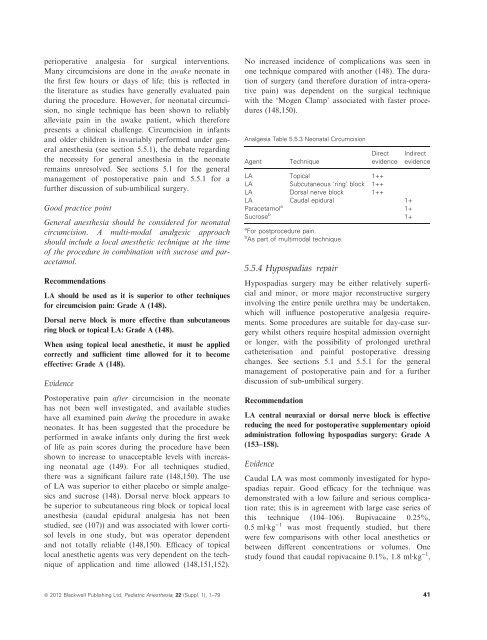Good Practice in Postoperative and Procedural Pain Management ...
Good Practice in Postoperative and Procedural Pain Management ...
Good Practice in Postoperative and Procedural Pain Management ...
You also want an ePaper? Increase the reach of your titles
YUMPU automatically turns print PDFs into web optimized ePapers that Google loves.
perioperative analgesia for surgical <strong>in</strong>terventions.Many circumcisions are done <strong>in</strong> the awake neonate <strong>in</strong>the first few hours or days of life; this is reflected <strong>in</strong>the literature as studies have generally evaluated pa<strong>in</strong>dur<strong>in</strong>g the procedure. However, for neonatal circumcision,no s<strong>in</strong>gle technique has been shown to reliablyalleviate pa<strong>in</strong> <strong>in</strong> the awake patient, which thereforepresents a cl<strong>in</strong>ical challenge. Circumcision <strong>in</strong> <strong>in</strong>fants<strong>and</strong> older children is <strong>in</strong>variably performed under generalanesthesia (see section 5.5.1), the debate regard<strong>in</strong>gthe necessity for general anesthesia <strong>in</strong> the neonaterema<strong>in</strong>s unresolved. See sections 5.1 for the generalmanagement of postoperative pa<strong>in</strong> <strong>and</strong> 5.5.1 for afurther discussion of sub-umbilical surgery.<strong>Good</strong> practice po<strong>in</strong>tGeneral anesthesia should be considered for neonatalcircumcision. A multi-modal analgesic approachshould <strong>in</strong>clude a local anesthetic technique at the timeof the procedure <strong>in</strong> comb<strong>in</strong>ation with sucrose <strong>and</strong> paracetamol.RecommendationsLA should be used as it is superior to other techniquesfor circumcision pa<strong>in</strong>: Grade A (148).Dorsal nerve block is more effective than subcutaneousr<strong>in</strong>g block or topical LA: Grade A (148).When us<strong>in</strong>g topical local anesthetic, it must be appliedcorrectly <strong>and</strong> sufficient time allowed for it to becomeeffective: Grade A (148).Evidence<strong>Postoperative</strong> pa<strong>in</strong> after circumcision <strong>in</strong> the neonatehas not been well <strong>in</strong>vestigated, <strong>and</strong> available studieshave all exam<strong>in</strong>ed pa<strong>in</strong> dur<strong>in</strong>g the procedure <strong>in</strong> awakeneonates. It has been suggested that the procedure beperformed <strong>in</strong> awake <strong>in</strong>fants only dur<strong>in</strong>g the first weekof life as pa<strong>in</strong> scores dur<strong>in</strong>g the procedure have beenshown to <strong>in</strong>crease to unacceptable levels with <strong>in</strong>creas<strong>in</strong>gneonatal age (149). For all techniques studied,there was a significant failure rate (148,150). The useof LA was superior to either placebo or simple analgesics<strong>and</strong> sucrose (148). Dorsal nerve block appears tobe superior to subcutaneous r<strong>in</strong>g block or topical localanesthesia (caudal epidural analgesia has not beenstudied, see (107)) <strong>and</strong> was associated with lower cortisollevels <strong>in</strong> one study, but was operator dependent<strong>and</strong> not totally reliable (148,150). Efficacy of topicallocal anesthetic agents was very dependent on the techniqueof application <strong>and</strong> time allowed (148,151,152).No <strong>in</strong>creased <strong>in</strong>cidence of complications was seen <strong>in</strong>one technique compared with another (148). The durationof surgery (<strong>and</strong> therefore duration of <strong>in</strong>tra-operativepa<strong>in</strong>) was dependent on the surgical techniquewith the ‘Mogen Clamp’ associated with faster procedures(148,150).Analgesia Table 5.5.3 Neonatal CircumcisionAgentTechniqueDirectevidenceLA Topical 1++LA Subcutaneous ‘r<strong>in</strong>g’ block 1++LA Dorsal nerve block 1++LA Caudal epidural 1+Paracetamol a 1+Sucrose b 1+a For postprocedure pa<strong>in</strong>.b As part of multimodal technique.5.5.4 Hypospadias repairIndirectevidenceHypospadias surgery may be either relatively superficial<strong>and</strong> m<strong>in</strong>or, or more major reconstructive surgery<strong>in</strong>volv<strong>in</strong>g the entire penile urethra may be undertaken,which will <strong>in</strong>fluence postoperative analgesia requirements.Some procedures are suitable for day-case surgerywhilst others require hospital admission overnightor longer, with the possibility of prolonged urethralcatheterisation <strong>and</strong> pa<strong>in</strong>ful postoperative dress<strong>in</strong>gchanges. See sections 5.1 <strong>and</strong> 5.5.1 for the generalmanagement of postoperative pa<strong>in</strong> <strong>and</strong> for a furtherdiscussion of sub-umbilical surgery.RecommendationLA central neuraxial or dorsal nerve block is effectivereduc<strong>in</strong>g the need for postoperative supplementary opioidadm<strong>in</strong>istration follow<strong>in</strong>g hypospadias surgery: Grade A(153–158).EvidenceCaudal LA was most commonly <strong>in</strong>vestigated for hypospadiasrepair. <strong>Good</strong> efficacy for the technique wasdemonstrated with a low failure <strong>and</strong> serious complicationrate; this is <strong>in</strong> agreement with large case series ofthis technique (104–106). Bupivaca<strong>in</strong>e 0.25%,0.5 mlÆkg )1 was most frequently studied, but therewere few comparisons with other local anesthetics orbetween different concentrations or volumes. Onestudy found that caudal ropivaca<strong>in</strong>e 0.1%, 1.8 mlÆkg )1 ,ª 2012 Blackwell Publish<strong>in</strong>g Ltd, Pediatric Anesthesia, 22 (Suppl. 1), 1–79 41
















